
Dalmatia is one of the four historical regions of Croatia, alongside Central Croatia, Slavonia, and Istria, located on the east shore of the Adriatic Sea in Croatia.

Dubrovnik, historically known as Ragusa, is a city in southern Dalmatia, Croatia, by the Adriatic Sea. It is one of the most prominent tourist destinations in the Mediterranean, a seaport and the centre of the Dubrovnik-Neretva County. Its total population is 41,562. In 1979, the city of Dubrovnik was added to the UNESCO list of World Heritage Sites in recognition of its outstanding medieval architecture and fortified old town.
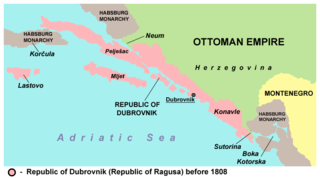
Dalmatian or Dalmatic was a group of Romance varieties that developed along the coast of Dalmatia. Over the centuries they were increasingly influenced, and then supplanted, by Croatian and Venetian.
This article contains information about the literary events and publications of 1774.
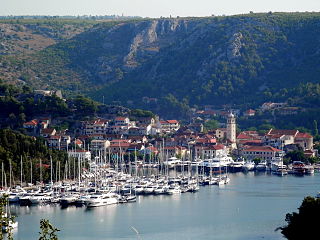
Skradin is a small town in the Šibenik-Knin County of Croatia. It is located near the Krka river and at the entrance to the Krka National Park, 17 km (11 mi) from Šibenik and 100 km (62 mi) from Split. The main attraction of the park, Slapovi Krke, is a series of waterfalls, the biggest of which, Skradinski buk, was named after Skradin.

Morlachs has been an exonym used for a rural Christian community in Herzegovina, Lika and the Dalmatian Hinterland. The term was initially used for a bilingual Vlach pastoralist community in the mountains of Croatia from the second half of the 14th until the early 16th century. Then, when the community straddled the Venetian–Ottoman border until the 17th century, it referred only to the Slavic-speaking people of the Dalmatian Hinterland, Orthodox and Catholic, on both the Venetian and Turkish side. The exonym ceased to be used in an ethnic sense by the end of the 18th century, and came to be viewed as derogatory, but has been renewed as a social or cultural anthropological subject. As the nation-building of the 19th century proceeded, the Vlach/Morlach population residing with the Croats and Serbs of the Dalmatian Hinterland espoused either a Serb or Croat ethnic identity, but preserved some common sociocultural outlines.
Franco Sacchetti, was an Italian poet and novelist.

The Uskoks were irregular soldiers in Habsburg Croatia that inhabited areas on the eastern Adriatic coast and surrounding territories during the Ottoman wars in Europe. Bands of Uskoks fought a guerrilla war against the Ottomans, and they formed small units and rowed swift boats. Since the uskoks were checked on land and were rarely paid their annual subsidy, they resorted to acts of piracy.
The History of Dalmatia concerns the history of the area that covers eastern coast of the Adriatic Sea and its inland regions, from the 2nd century BC up to the present day. The region was populated by Illyrian tribes around 1,000 B.C, including the Delmatae, who formed a kingdom and for whom the province is named. Later it was conquered by Rome, thus becoming the province of Dalmatia, part of the Roman Empire. Dalmatia was ravaged by barbaric tribes in the beginning of the 4th century.

The Republic of Ragusa was an aristocratic maritime republic centered on the city of Dubrovnik in South Dalmatia that carried that name from 1358 until 1808. It reached its commercial peak in the 15th and the 16th centuries, before being conquered by Napoleon's French Empire and formally annexed by the Napoleonic Kingdom of Italy in 1808. It had a population of about 30,000 people, of whom 5,000 lived within the city walls. Its motto was "Non bene pro toto libertas venditur auro", a Latin phrase which can be translated as "Liberty is not well sold for all the gold".
Literature of the 18th century refers to world literature produced during the years 1700–1799.

Stojan Janković Mitrović was the commander of the Morlach troops in the service of the Republic of Venice, from 1669 until his death in 1687. He participated in the Cretan and Great Turkish War, as the supreme commander of the Venetian Morlach troops, of which he is enumerated in Croatian and Serbian epic poetry. He was one of the best-known uskok/hajduk leaders of Dalmatia.
The Serb-Catholic movement in Dubrovnik was a cultural and political movement of people from Dubrovnik who, while Catholic, declared themselves Serbs, while Dubrovnik was part of the Habsburg-ruled Kingdom of Dalmatia in the 19th and early 20th centuries. Initially spearheaded by intellectuals who espoused strong pro-Serbian sentiments, there were two prominent incarnations of the movement: an early pan-Slavic phase under Matija Ban and Medo Pucić that corresponded to the Illyrian movement, and a later, more Serbian nationalist group that was active between the 1880s and 1908, including a large number of Dubrovnik intellectuals at the time. The movement, whose adherents are known as Serb-Catholics or Catholic Serbs, largely disappeared with the creation of Yugoslavia.

Morlachia was a vaguely defined region, named after the Morlachs, used on European maps between the 16th and the 19th centuries. Morlachia was located in modern-day Croatia between Istria and Dalmatia, being opposite to the island of Krk. The Morlachs were originally a Romance people related to modern Romanians before their Slavicisation.

Hasanaginica, also Asanaginica, is a South Slavic folk ballad, created during the period of 1646–49, in the region of Imotski, which at the time was a part of the Bosnia Eyalet of the Ottoman Empire.
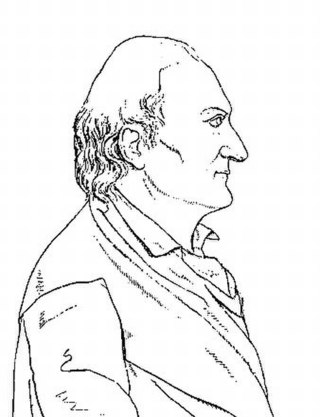
Alberto Fortis was an Italian writer, naturalist and cartographer, citizen of Republic of Venice.
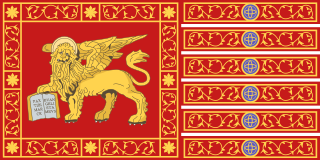
Venetian Dalmatia refers to parts of Dalmatia under the rule of the Republic of Venice, mainly from the 15th to the 18th centuries. Dalmatia was first sold to Venice in 1409 but Venetian Dalmatia was not fully consolidated until 1420. It lasted until 1797, when the Republic of Venice fell to the forces of Napoleon Bonaparte and Habsburg Austria.

Dalmatian city-states were formerly Roman municipalities in Dalmatia where the local Romance population survived the Barbarian invasions after the fall of the Western Roman Empire in the 400s CE. Eight little cities were created by the indigenous Illyro-Roman inhabitants of the region, who maintained political links with the Eastern Roman Empire, which in return defended these cities, enabling their commercial trade with Byzantium.

The Smiljanić family (Smogianich) were a Vlach/Morlach family originating from Lika and first mentioned in the 17th century, when the oldest member Petar Smiljanić was a harambaša and capo (head) of the Morlach troops in Venetian service during the Cretan War (1645–69), in Venetian Dalmatia. He was born in Udbina, in the Lika region, then moved with his family to Venetian Dalmatia in 1647. From the family originated nine serdars, who participated in the Cretan War (1645–69) and Morean War (1684–1699). The family and its members are also perceived as Croatian, and Serbian in national historiographies.
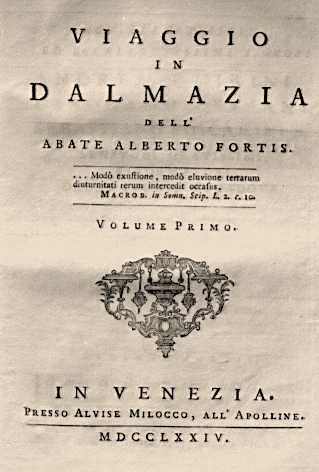
Viaggio in Dalmazia, also known by its full title Viaggio in Dalmazia dell'abate Alberto Fortis, is a 1774 book by the Venetian writer Alberto Fortis, published in the city of Venice. On it, Fortis recounted his journey to Dalmatia, a region now in Croatia. He described the region, its mineral resources and its inhabitants and their way of life, paying great attention to the native Morlachs.















